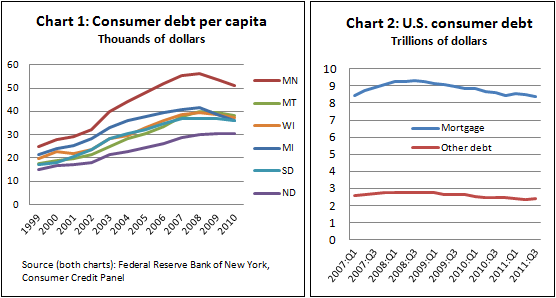This Christmas shopping season is shaping up to be fairly robust. The National Retail Federation was forecasting a modest increase of about 3 percent for this holiday season, but later reported that shoppers spent a record $52 billion during the kickoff Black Friday weekend.
If Santa proves to be comparatively generous this year, the reasons are likely many. For example, consumer confidence has been on the rise of late, according to indexes from both the Conference Board and the University of Michigan.
Households might also be feeling better about their financial ability to splurge a little because per capita debt has fallen across the district since the start of the recession, according to the Consumer Credit Panel, produced quarterly by the Federal Reserve Bank of New York (see Chart 1). Somewhat ironically, the lone anomaly in that trend is flattening debt in North Dakota, whose economy never officially went into recession and has seen strong job and wage growth. Minnesota is also notable for the fact that its average debt is considerably higher than any other district state, including Wisconsin, with which it shares many social and economic similarities.
Panel data for 2011 are not available for all states. But the panel tracks a set of 11, mostly larger, U.S. states (including Michigan) on a more regular basis, and debt trends continue to be favorable for this group. For example, much of the average debt is buried in home mortgages. States vary in the amount of total debt made up of mortgages; nationwide it’s a little less than 80 percent. But total mortgage debt has continued to drop through the third quarter of this year, according the New York Fed figures. Equally important in terms of purchasing power, other outstanding debt (like credit cards and home equity and auto loans) also has been falling, save for a tiny bump in the third quarter of this year (see Chart 2).
Some of the debt improvement might be a tad superficial, such as debts discharged through bankruptcies, which remain elevated. But other indicators suggest better overall financial health. For example, the percentage of mortgages more than 90 days late nationwide has fallen five consecutive quarters (through the second quarter of 2011, the most recent panel data). In Michigan, the percentage of seriously delinquent mortgages fell from a peak of 7.8 percent in the fourth quarter of 2009 to 5.7 percent last summer; the percentage of consumers with new foreclosures also has been cut in half since its peak in the second quarter of 2009.

The New York Fed’s Consumer Credit Panel consists of detailed credit-report data from the private firm Equifax that allow for longitudinal quarterly data on individuals and households from 1999 to 2011. The panel is a nationally representative 5 percent random sample of all individuals with a Social Security number and a credit report (usually aged 19 and over). Additional individuals living at the same address are also sampled, which allows the panel to track household-level credit and debt. The resulting database includes approximately 40 million individuals in each quarter.
Ron Wirtz is a Minneapolis Fed regional outreach director. Ron tracks current business conditions, with a focus on employment and wages, construction, real estate, consumer spending, and tourism. In this role, he networks with businesses in the Bank’s six-state region and gives frequent speeches on economic conditions. Follow him on Twitter @RonWirtz.





